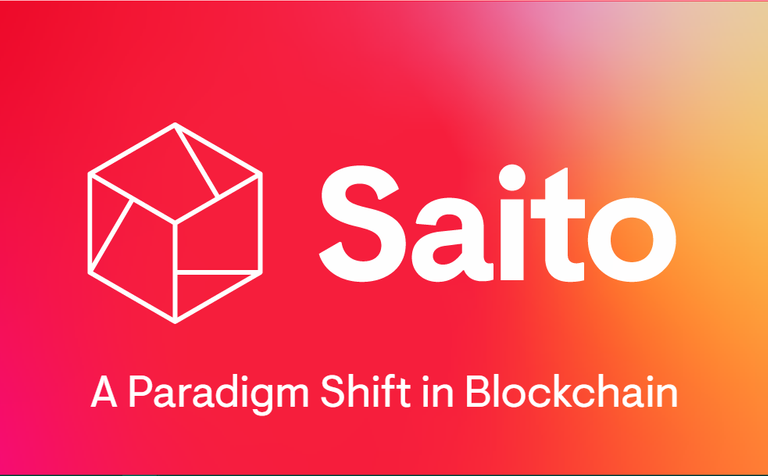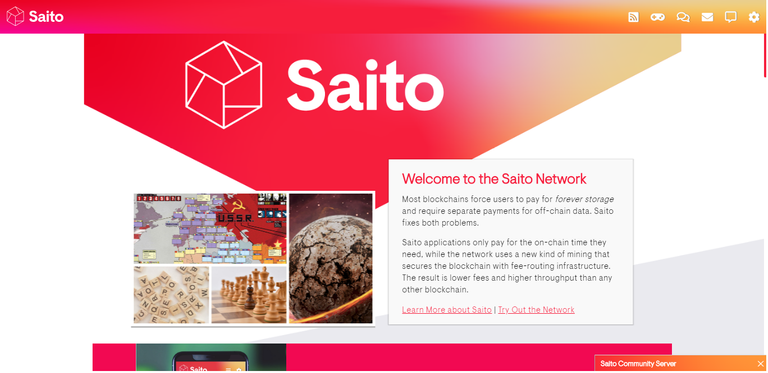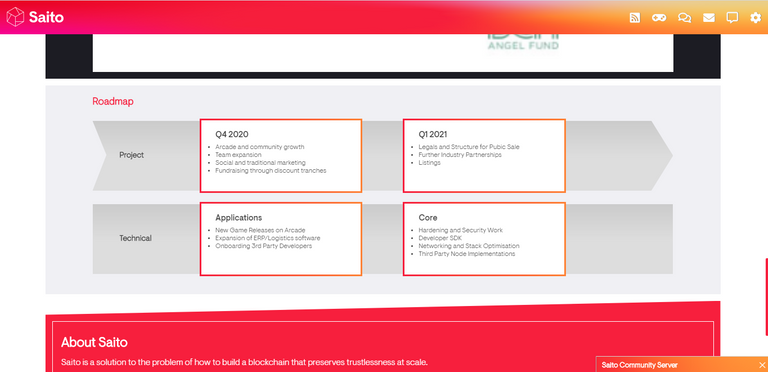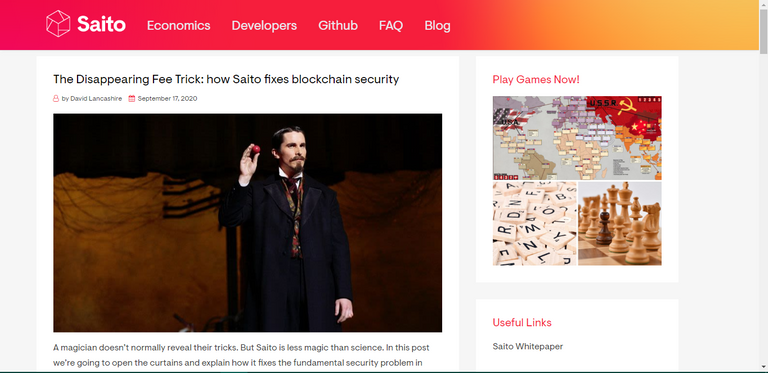
Saito News
A little over a month ago I told you about saito, here is the post:
Ya hace poco mas de un mes les hable de saito, aqui el post:
In it I talked about how the games were and how to start in the same in easy ways, so you could start generating money. Now we will see some new graphic improvements, along with them come some technical details extracted from the same Whitepaper, which explains the two main reasons why saito is a new way of seeing the blockchain.
En el mismo hable de como eran los juegos y como empezar en el mismo de formas fáciles, así podías comenzar a generar dinero. Ahora vamos a ver unas nuevas mejoras graficas, junto a las mismas vienen algunos detalles tecnicos extraidos desde el mismo Whitepaper, en el que se explica las dos grandes razones por la cual saito es una nueva manera de ver la blockchain.
New front image
Nueva imagen frontal

Without anything else to anticipate see, to enter saito.io the first thing we will see this time will be this new image, more dynamic, more compact.
Sin nada mas que anticipar veamos, al entrar en saito.io lo primero que veremos esta vez sera esta nueva imagen, mas dinamica, mas compacta.

If we go down a little, we will see the roadmap, among other things, as some sponsors and some things of the page, very dynamic everything and very well explained to just be images.
Si bajamos un poco, veremos el roadmap, entre otras cosas, como algunos patrocinadores y algunas cosas de la pagina, muy dinamico todo y muy bien explicado para solo ser imagenes.

When we return to the top we will see that there is a new icon, which leads us directly to a blog, yes, a blog in which mostly the developers give their new news and give some extra information.
Al volver a la parte superior veremos que hay un nuevo icono, que nos lleva directamente a un blog, si, un blog en el que mayormente los desarrolladores dan sus nuevas noticias y dan alguna que otra informacion extra.
new referral system interface.
nueva interfaz de sistema de refereridos.

Just two days ago a new referral interface was added, where it shows you everything that your little grasshopper does in saito, when he joined and how much you have earned by bringing a new friend to the network.
Starting from the top of the image, right there we see the amount of saitos you have, the one you have inside blocks for your next reward and the ones you have spent to receive more rewards after that we can clearly see a referral, which would be @franzzonline, he has earned 60 saitos for his part, of which I also earned 6 extras, besides that we also see that there are some tasks to complete at the bottom, when you complete those tasks you will have saitos directly in your wallet to start having much more progressively.
Hace justamente dos dias se añadio una nueva interfaz de referidos, donde la misma te muestra todo lo que hace tu pequeño saltamontes en saito, cuando se unio y cuanto has ganado tu por traer un nuevo amigo a la red, Comenzando desde la parte superior de la imagen, ahi mismo vemos la cantidad de saitos que tienes, la que tienes dentro de bloques para tu proxima recompensa y los que has gastado para recibir mas recompensas luego de eso podemos ver claramente a un referido, que seria @franzzonline, el ha ganado 60 saitos por su parte, de los cuales yo tambien gane 6 extras, ademas de eso tambien vemos que hay unas tareas por completar en la parte inferior, al completar esas tareas tendras saitos directo en tu billetera para comenzar a tener mucho mas progresivamente.
Saito's white paper is this one:
El white paper de saito es este :
There are given to understand with more depth the points that I take next that are only the two major ones that it tries to solve, in the whitepaper you will read them more thoroughly, I give a review only touching small points of the same one
Ahí se dan a entender con mayor profundidad los puntos que tomo a continuación que son solamente los dos mayores que trata de solventar, en el whitepaper los leerás mas a fondo, yo doy una revisión solamente tocando pequeños puntos del mismo

Everything written below is an extraction from the saito whitepaper, in which it is explained a little better how the transactions are made to facilitate their understanding.
Todo lo escrito a continuacion es una extracción del whitepaper de saito, en el cual se explica un poco mejor el como se realizan las transacciones para facilitar su comprensión.
Saito is a blockchain designed to solve the problems of collective action that prevent the escalation in its test of work in its test of work and test of stake in the blockchain, its whitepaper explains the mechanism and in which the same transactions are those which underneath the layer of the network would be processed and likewise with a system that would avoid that the same one is attacked with several types of attacks to the same one.
Saito es una blockchain diseñada para solventar los problemas de accion colectiva que impiden el escalamiento en su prueba de trabajo en su prueba de trabajo y prueba de stake en las blockchain, su whitepaper explica el mecanismo y en el cual las mismas transacciones son aquellas las cuales por debajo de la capa de la red se irian procesando y asi mismo con un sistema que evitaria que la misma sea atacada con varios tipos de ataques a la misma.Basicamente, saito esta aplicada para enviar grandes cantidades de data por red PKI la cual se podria usar para construir varios servicios descentralizadas de servicios de alta data, servicios de juegos en linea pay-to-play y muchas cosas mas
The problem

The problem of the escalation in the blockchain is not the network as such, since the network is becoming even bigger with every second, if you had the resources to pay for the necessary equipment there would be nothing that prevents building a blockchain as big as the public internet network, what prevents the growth would not be the cost of it, this question has been avoided by saying that whoever makes money with it, He must pay the expenses to maintain it and there are two failures that are the problem of tragedy of common and the problem of parasitism that leads to a systemic insufficiency of unpaid network services, neither is harmful on a small scale, but both become increasingly disabling as bandwidth and storage costs go up.
El problema
El problema de la escalada en la blockchain no es la red como tal, ya que la red esta volviendose aun mas grande con cada segundo, si se tuviera los recursos para pagar por el equipo necesario no habria nada que impida construir una blockchain tan grande como la red de internet publica, lo que impide el crecimiento no seria el costo de la misma, se ha evitado esta pregunta diciendo que aquel que gane dinero con la misma, el debe pagar los gastos para mantenerla y hay dos fallos que son el problema de tragedia de comunes y el de parasitismo que lleva a una insuficiencia sistemica de servicios de red no renumerados, ninguno es dañino a pequeña escala, pero ambos se vuelven cada vez más incapacitantes a medida que los costos de ancho de banda y almacenamiento van en ascenso.
THE TRAGEDY OF THE COMMONS

Saito solves the problem by allowing network nodes to remove older blocks at predictable intervals (called epochs) where the length of the block is specified in the consensus code. In extreme cases, a blockchain designed to handle global email traffic can have a time period as short as 24 hours. Saito specifies that once a block falls outside the current time period, its unspent transaction outputs (UTXO) are no longer expendable. But any UTXO from that set that contains enough chips to pay a relay fee must be re-included in the next block. Block producers do this by creating special "automatic transaction relay" (ATR) transactions that include the data from the original transaction, but have completely new and therefore freshly spent UTXOs. After two periods, the block producers can delete all data in the block, although the 32-byte header hash can be retained to prove the connection to the original genesis block. The ATR mechanism completely fixes the tragedy of the commons problem, while making it impossible for a block chain to grow so large that it collapses.
THE TRAGEDY OF THE COMMONS ( La tragedia de los bienes comunales )
Saito resuelve el problema permitiendo a los nodos de la red eliminar los bloques de mayor antigüedad en intervalos predecibles ( Llamese epocas) donde la longitud del mismo se especifica en el código de consenso. En caso extremo una blockchain diseñada para manejar trafico de email global, puede tener una epoca tan corta como de 24h Saito especifica que una vez que un bloque cae fuera de la época actual, sus salidas de transacciones no gastadas (UTXO) ya no son gastables. Pero cualquier UTXO de ese conjunto que contenga suficientes fichas para pagar una tarifa de retransmisión debe ser re-incluida en el siguiente bloque. Los productores de bloques lo hacen creando transacciones especiales de "retransmisión automática de transacciones" (ATR) que incluyen los datos de la transacción original, pero que tienen UTXO completamente nuevas y, por lo tanto, recién gastadas. Después de dos épocas, los productores de bloques pueden eliminar todos los datos del bloque, aunque el hash de cabecera de 32 bytes puede conservarse para demostrar la conexión con el bloque de génesis original. El mecanismo de ATR arregla completamente la tragedia del problema de los bienes comunes, mientras que hace imposible que una cadena de bloques crezca tanto que se colapse.
Or as I say, a system of self-recycling information. Now you will say, well but it erases the information in a certain way, it is not like that, since in http://Saito.io/explorer you will see reflected the movement in that block.
O como yo le digo, un sistema de autoreciclaje de informacion. Ahora tu diras, bueno pero se borra la informacion de cierta manera, no es asi, ya que en http://Saito.io/explorer igual se vera reflejado el movimiento en ese bloque.
ELIMINATING FREE RIDING PROBLEM.

In Saito any node can create a block at any time as long as it includes enough "routing work". The amount of "routing work" needed to produce a block depends on how quickly a block follows its predecessor: consensus rules increase the value immediately after a block is found and decrease it gradually until it reaches zero. Since block producers will issue blocks as soon as it becomes profitable, the rate of block production is determined by the total amount of "routing work" generated by the network.
ELIMINANDO EL PARASITISMO.
En Saito cualquier nodo puede crear un bloque en cualquier momento siempre y cuando incluya suficiente "trabajo de enrutamiento". La cantidad de "trabajo de enrutamiento" necesario para producir un bloque depende de la rapidez con la que un bloque sigue a su predecesor: las reglas de consenso aumentan el valor inmediatamente después de que se encuentre un bloque y disminuya ...gradualmente hasta llegar a cero. Ya que los productores de bloques emitirán bloques tan pronto como se convierta rentable, el ritmo de la producción de bloques está determinado por la cantidad total de "trabajo de enrutamiento" generada por la red.
Saito derives the routing work from the transaction value that is paid for each transaction. Using this measure of work to produce blocks makes attacking the network costly, as any increase in the rate of block production requires attackers to pay more in transaction fees than the network is collecting.
Saito deriva el trabajo de enrutamiento del valor de la de la transacción que se paga por cada transacción. Usando esta medida de trabajo para producir bloques hace atacar la red es costoso, ya que cualquier aumento en el ritmo de producción de bloques requiere los atacantes a pagar más en concepto de honorarios de transacción que que la red está recolectando.

To prevent attackers from stealing routing work, Saito has its routing nodes cryptographically sign transactions as they propagate into the block producers. The consensus rules specify that the amount of "routing work" provided by a transaction decreases with each hop that the transaction takes across the network, and that transactions provide zero routing work to nodes that are not included in this routing route. The "work" that the network is measuring is essentially the collection and efficient distribution of the incoming network fees. We note that as long as there is no payment for block production, this system offers security comparable to that of Bitcoin: the cost of a chain reorganization can always be quantified. Attackers need to spend their own money to attack the chain, allowing users who require significant guarantees against irreversibility to wait for an appropriate number of confirmations.
Para evitar que los atacantes roben el trabajo de enrutamiento, Saito hace que sus nodos de enrutamiento firmen criptográficamente las transacciones a medida que se propagan hacia el interior de los productores de bloques. Las reglas de consenso especifican que la cantidad de "trabajo de enrutamiento" que proporciona una transacción disminuye con cada salto que la transacción da a través de la red, y que las transacciones proporcionan cero trabajo de enrutamiento a los nodos que no están incluidos en esta ruta de enrutamiento. El "trabajo" que la red está midiendo es esencialmente la recaudación y el reparto eficiente de las tasas de la red de entrada. Observamos que mientras no haya un pago por la producción de bloques, este sistema ofrece una seguridad comparable a la de Bitcoin: el coste de una reorganización de la cadena siempre se puede cuantificar. Los atacantes necesitan gastar su propio dinero para atacar la cadena, permitiendo a los usuarios que requieren garantías significativas contra la irreversibilidad esperar un número apropiado de confirmaciones.
In conclusion.
Saito has an innovative way of facing these problems, problems that not many have tried to solve, which is brave, to take something that nobody wants to run into and give it a face for itself, they have a part where there are comments from people and I like very much one that says ¨ Pay attention to these guys ¨ because I think it's something big
En conclusion.
Saito tiene una manera innovadora de afrontar estos problemas, problemas que no muchos han intentado resolver, cosa que es de valientes, el tomar algo que nadie se quiere topar y darle cara por si mismo, ellos tienen una parte donde hay comentarios de personas y me gusta mucho uno que dice ¨Prestenle atencion a estos chicos¨ porque me parece que es algo grande
Thanks for reading, if it was to your liking you could leave a comment, I will be reading them and replying.
Gracias por leer, si fue de tu agrado podrias dejar un comentario, los estaré leyendo y respondiendo.
Join saito
Saito
Saito tech
Saito Discord
Saito telegram
Sources:
Commons tragedy
Problem source
Parasite poster
Stealing hand
All other images were taken from Saito.io
Posted Using LeoFinance Beta
Muy interesante amigo, el pana lunatic me ha estado invitando pero no entendía mucho como interactuar en la blockchain. Ahora mismo voy a tu primera publicación, para ver si logro comprender bien
Bro, puedo crear partidas. Pero dónde puedo ver las que ya se han creado paro yo aceptar las de los otros
Heyyyy si yo empece a jugar ahi a eso de junio y juego de a ratos, deberias avisarme y jugamos un dia, mi telegram es @imlegendarius. Asi tambien te podria explicar un poco mejor todo!
Listo, soy tu referido. Te contacto entonces!
Congratulations @jeduardoz! You have completed the following achievement on the Hive blockchain and have been rewarded with new badge(s) :
You can view your badges on your board and compare yourself to others in the Ranking
If you no longer want to receive notifications, reply to this comment with the word
STOP